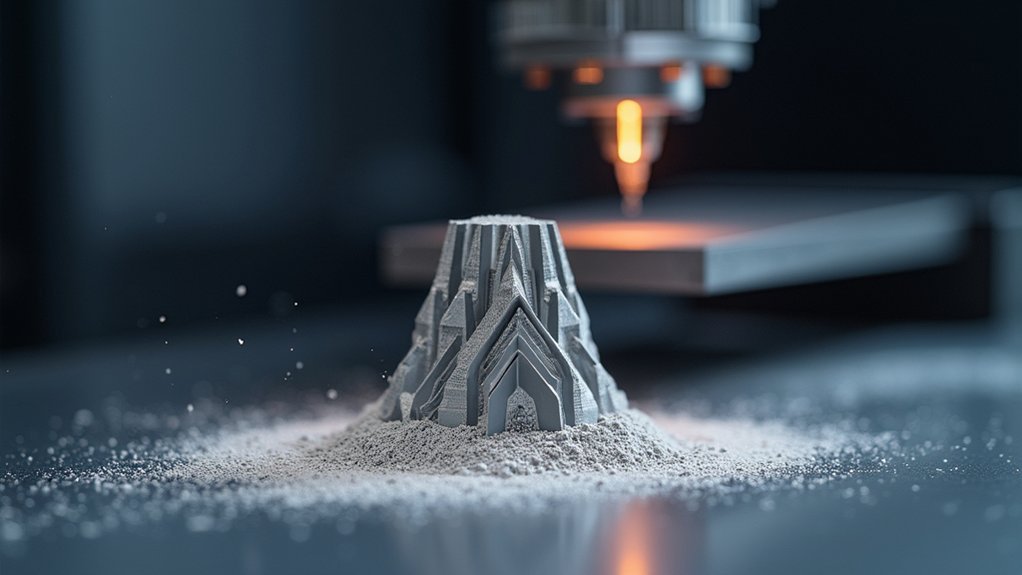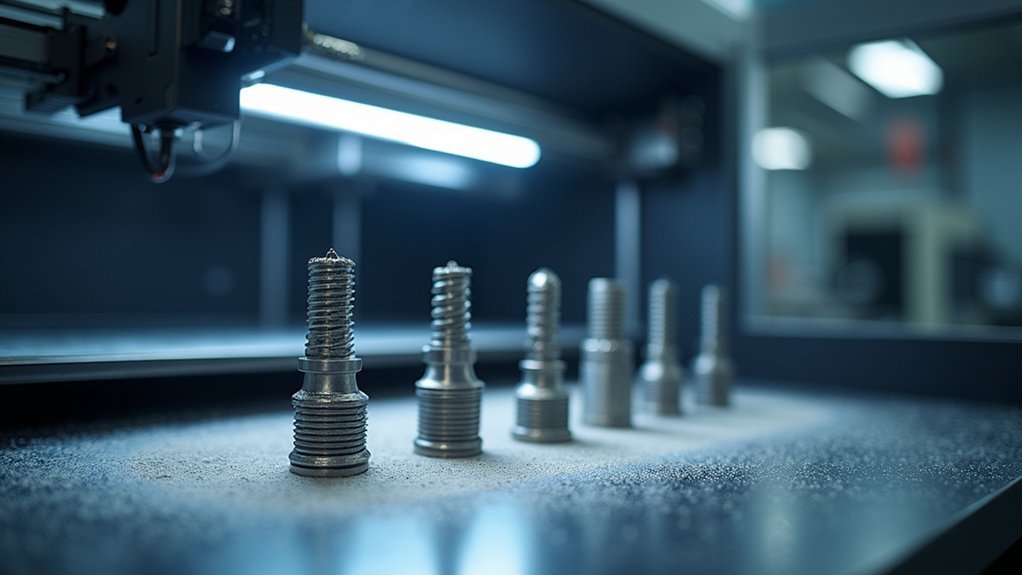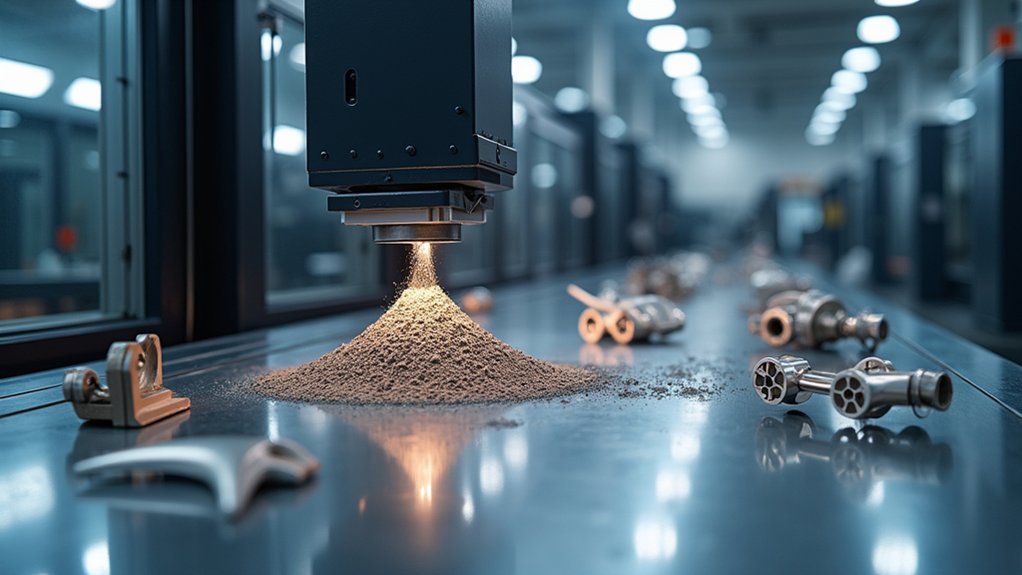Powder bed fusion technology transforms how you manufacture critical components across aerospace, automotive, medical, energy, and electronics industries. You’ll achieve complex geometries impossible with traditional methods, like GE’s fuel nozzles and Bugatti’s lightweight titanium brake calipers. The technology enables patient-specific medical implants, conformal cooling channels, and rapid prototyping while reducing material waste by 95-98%. You can consolidate multiple parts into single optimized designs, improving efficiency and sustainability. Continue exploring to discover specific applications transforming each sector.
Aerospace Manufacturing and Component Production

When you examine the aerospace industry’s adoption of Powder Bed Fusion technology, you’ll find it’s revolutionizing how manufacturers produce critical components like turbine blades and fuel nozzles.
You’re witnessing remarkable improvements in fuel efficiency and performance through lightweight designs previously impossible with traditional manufacturing.
Powder Bed Fusion enables unprecedented lightweight aerospace designs, delivering fuel efficiency and performance breakthroughs unattainable through conventional manufacturing methods.
The GE9X engine demonstrates PBF’s potential with 3D-printed fuel nozzles that enhance thermal efficiency while reducing part count.
You’ll discover that complex geometries, including intricate internal cooling channels in turbine engines, become achievable through this technology.
Boeing’s 777x engines showcase PBF’s impact with over 300 3D-printed parts contributing to 10% fuel efficiency gains.
You’re seeing component consolidation that reduces assembly time, minimizes weight, and supports the aerospace industry’s sustainability goals through advanced manufacturing capabilities.
Automotive Industry Applications and Innovation
Beyond aerospace applications, the automotive industry has embraced Powder Bed Fusion technology to transform vehicle manufacturing and design capabilities.
You’ll find manufacturers leveraging this technology to create lightweight components that enhance vehicle efficiency and performance, particularly benefiting electric vehicle development.
The automotive industry utilizes powder bed fusion for several breakthrough applications:
- Rapid prototyping – You can quickly iterate designs and conduct functional testing, dramatically reducing development timelines.
- Component consolidation – General Motors combines eight seat belt bracket components into one optimized design.
- Premium brake systems – Bugatti’s titanium brake calipers achieve 40% weight reduction while increasing strength.
- Enhanced cooling systems – Conformal cooling channels improve thermal management in engine parts.
This technology revolutionizes how you approach automotive manufacturing, enabling complex geometries impossible with traditional methods.
Medical Device Manufacturing and Custom Implants

You’ll find that powder bed fusion revolutionizes medical device manufacturing by enabling patient-specific implant design using your CT-scan data to create hip joints and knee replacements perfectly matched to your anatomy.
The technology’s compatibility with biocompatible materials like titanium and cobalt-chrome alloys guarantees your implants integrate seamlessly with bone tissue while minimizing complications.
Custom surgical guides produced through this process enhance precision during your procedures, resulting in less invasive surgeries and faster recovery times.
Patient-Specific Implant Design
Although traditional implant manufacturing relies on standardized sizes that rarely match individual anatomy perfectly, powder bed fusion revolutionizes patient care by creating implants tailored to each person’s unique physiological requirements.
This technology transforms CT-scan data into patient-specific implants that achieve perfect anatomical fits, greatly enhancing surgical outcomes and recovery times.
Key advantages of powder bed fusion in implant design include:
- Biocompatible materials like titanium and cobalt-chrome alloys that promote superior bone integration
- Custom surgical guides that increase procedural accuracy while reducing invasiveness
- Complex geometries in spinal implants that optimize biological integration for enhanced comfort
- Rapid prototyping capabilities that guarantee timely availability of critical medical devices for urgent patient needs
You’ll experience improved patient safety and notably better post-surgical outcomes.
Biocompatible Material Selection
When selecting materials for powder bed fusion in medical applications, biocompatibility becomes the paramount consideration that determines implant success or failure. You’ll find that biocompatible titanium stands out as the gold standard, offering exceptional compatibility with human tissue while minimizing rejection rates. Cobalt-chrome alloys provide additional options for specific applications requiring enhanced durability.
| Material | Primary Benefits | Common Applications |
|---|---|---|
| Biocompatible Titanium | Superior tissue compatibility, corrosion resistance | Custom knee joints, jaw reconstructions |
| Cobalt-Chrome Alloys | High strength, wear resistance | Hip implants, dental prosthetics |
Your patient-specific implants benefit from these materials’ ability to form complex porous structures through powder bed fusion, promoting bone integration and accelerating healing. This material selection directly impacts recovery times and overall implant functionality.
Surgical Precision Enhancement
Powder bed fusion revolutionizes surgical precision by transforming patient-specific anatomical data into perfectly fitted medical devices that enhance procedural accuracy.
You’ll find that CT-scan data enables the creation of patient-specific implants like hip and knee replacements tailored to individual anatomy, considerably improving surgical outcomes.
Custom surgical guides produced through this technology enhance your procedural accuracy while reducing invasiveness, leading to better patient experiences and faster recovery times.
The process leverages biocompatible materials including titanium and cobalt-chrome alloys to create dental components that fit patients precisely.
Key advantages include:
- Complex porous structures in spinal implants that optimize biological integration
- Rapid prototyping capabilities that accelerate critical medical device production
- Considerably reduced lead times for essential healthcare components
- Enhanced comfort and function through precise patient-specific fitting
Energy Sector and Power Generation Components

Since energy demands continue rising globally, you’ll find that Powder Bed Fusion technology transforms how power generation components are manufactured. This advanced manufacturing process enables you to create intricate cooling channels in gas turbine parts, greatly improving thermal efficiency and overall performance.
The energy sector benefits considerably from PBF’s ability to produce turbine blades designed for extreme temperatures and pressures, essential for reliable power generation.
You’ll notice reduced material waste as PBF creates complex geometries that optimize material usage. For oil and gas applications, you can manufacture corrosion-resistant components ensuring durability in harsh environments.
The energy sector increasingly adopts powder bed fusion to support sustainable practices, minimizing carbon emissions through lightweight, efficient components that enhance operational performance.
Tooling and Industrial Manufacturing Solutions
You’ll find that PBF transforms tooling manufacturing by enabling conformal cooling channels that precisely follow your mold’s geometry, dramatically improving heat dissipation compared to traditional straight-line cooling systems.
This enhanced thermal management extends your tooling’s lifespan while reducing cycle times in injection molding and die casting operations.
Additionally, you can produce wear-resistant components with complex internal structures that withstand high-stress industrial environments, minimizing downtime and replacement costs.
Conformal Cooling Channels
When traditional manufacturing methods fall short in creating complex cooling systems, conformal cooling channels emerge as a game-changing solution that revolutionizes thermal management in tooling applications.
Using powder bed fusion, you’ll achieve optimized thermal management that follows your part’s exact contours, markedly reducing cooling times and enhancing product quality.
These innovative channels deliver remarkable benefits:
- Reduced cycle times – You’ll experience considerably shorter cooling periods, boosting overall production efficiency.
- Improved part quality – Uniform cooling minimizes thermal gradients, preventing warping and defects in molded components.
- Enhanced tool longevity – Better heat distribution extends your mold and die lifespan, reducing replacement costs.
- Lower energy consumption – Efficient thermal management decreases power requirements, cutting operational expenses while maintaining consistent product quality across production runs.
Wear-Resistant Component Production
Beyond thermal optimization, powder bed fusion transforms the production of wear-resistant components that withstand the punishing demands of industrial environments.
You can manufacture parts with intricate geometries and optimized cooling channels that enhance mold, die, and tool efficiency, dramatically improving your overall manufacturing process.
Powder Bed Fusion enables you to create customized tooling solutions engineered for extreme conditions, reducing costly downtime and maintenance requirements.
These wear-resistant components endure harsh operational demands while maintaining reliability and durability throughout their extended service life.
You’ll streamline production and minimize material waste through complex, tailored designs that align with sustainable manufacturing practices.
This capability extends component lifespan in high-stress applications, delivering significant cost savings and operational efficiency improvements across your industrial operations.
Consumer Electronics and Product Development
Countless consumer electronics manufacturers now leverage powder bed fusion to create intricate designs that were impossible with traditional manufacturing methods.
Powder bed fusion enables electronics manufacturers to achieve complex geometries previously impossible through conventional production techniques.
You’ll find this technology revolutionizing product development by enabling complex geometries that optimize material usage while reducing weight. The process supports your sustainability goals through exceptional material efficiency.
Key advantages in consumer electronics include:
- Custom wearable technology – Create unique, personalized designs tailored to individual consumer preferences
- Limited-edition production – Support small batch manufacturing for exclusive brand offerings
- Enhanced device performance – Produce lightweight, durable components that extend product longevity
- Eco-friendly manufacturing – Reuse 95-98% of unused powder material for sustainable production
You can now manufacture high-end electronics with unprecedented design freedom while meeting modern demands for customization and environmental responsibility.
Research and Development Applications
While traditional prototyping methods can take weeks or months to produce a single iteration, powder bed fusion transforms your research timeline by delivering complex prototypes in days.
You’ll explore innovative designs impossible with conventional manufacturing, creating intricate internal channels, lattice structures, and geometries that push engineering boundaries.
Advanced materials expand your research capabilities across aerospace, automotive, and medical sectors. High-strength alloys and biocompatible materials enable performance testing under real-world conditions.
You can customize components for specific experimental requirements, optimizing parameters and testing variations efficiently.
Research and development partnerships between institutions and PBF providers accelerate innovation cycles.
You’ll iterate faster, test more concepts, and reduce development costs while maintaining precision. This flexibility allows targeted investigations that drive breakthrough discoveries across multiple industries.
Frequently Asked Questions
What Industries Use Powder Bed Fusion?
You’ll find powder bed fusion used in aerospace for turbine components, automotive for prototyping specialized parts, medical for patient-specific implants, energy for heat-resistant turbine parts, and consumer goods for customized wearable technology.
What Are the Applications of Powder Bed Fusion Process?
You’ll find powder bed fusion creates lightweight aerospace components, rapid automotive prototypes, patient-specific medical implants, durable energy sector parts, and intricate consumer electronics, enabling customization while reducing material waste across industries.
What Are the 7 Types of Additive Manufacturing?
You’ll find seven main additive manufacturing types: Stereolithography, Selective Laser Sintering, Selective Laser Melting, Fused Deposition Modeling, Electron Beam Melting, Digital Light Processing, and Laminated Object Manufacturing technologies.
What Are the New Applications of Additive Manufacturing?
You’ll find additive manufacturing creating patient-specific implants, lightweight automotive parts reducing weight by 40%, complex aerospace components improving fuel efficiency, enhanced gas turbine cooling systems, and custom tooling with optimized geometries extending equipment lifespan.





Leave a Reply